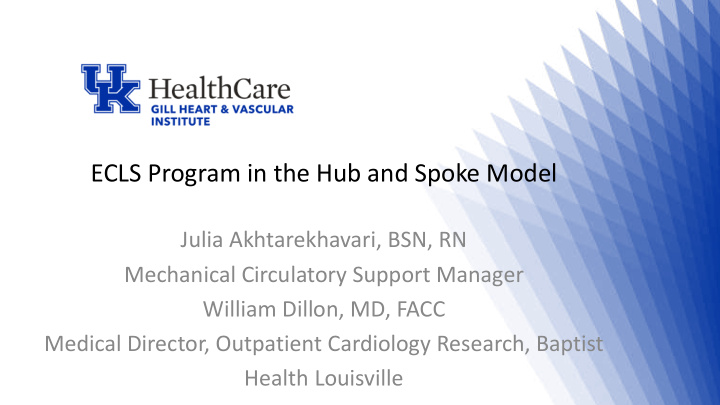



ECLS Program in the Hub and Spoke Model Julia Akhtarekhavari, BSN, RN Mechanical Circulatory Support Manager William Dillon, MD, FACC Medical Director, Outpatient Cardiology Research, Baptist Health Louisville
Faculty Disclosure • I have no financial disclosures.
Educational Need/Practice Gap • Gap = Development and rapid expansion of ECLS programs in low volume centers • Need = Decreased costs and improved mortality exist in high volume centers. Outcomes of transported ECLS patients are equivalent to non-transported ECLS patients.
Objectives Upon completion of this educational activity, you will be able to: 1. Discuss the benefits of an ECLS Hub and Spoke Model. 2. Review process of becoming an ECLS Spoke Center.
Expected Outcome • Consider use of hub and spoke model for initiation of ECLS program in low volume centers.
ECLS Volume Distribution (1989-2013) 5000 4500 4000 3500 Number of Cases 3000 2500 2000 1500 1000 500 0 1-5 6-14 15-30 30+ Annual Hospital Volume Barbaro, et al. Am J Respir Crit Care Med (2015)
Does Volume Matter in ECLS Volume = Outcomes ? Probably…to an extent
ECLS Center Volume 60 • Considerations: • Severity of illness 50 • Conservative vs. aggressive deployment 40 ECLS Cases • Cost 30 • Staff vs. center expertise 20 10 0 1 2 3 4 5 Year Huesch. ASAIO (2018)
Hub and Spoke
Training & Expertise • Learn from our experience and our mistakes • Didactic, wet lab, simulations • Initial/annual training • Consult peer to review candidates • Debrief cases
Resources & Cost • Ability to offer life saving technology • Little to no duplicate staff • Fewer high cost cases at spoke
Care Coordination & Outcomes • Patient selection criteria • Protocol alignment • Best possible outcomes
The Final Link - ECLS Transport
Multidisciplinary Collaboration Efforts
Protocol Development & Training Didactic classwork, protocol education and high fidelity simulation to transport ECMO patients Core team of 4: • Cardio-Thoracic Vascular critical care nurse • Perfusionist • Paramedic • EMT/Paramedic Driver
UKHC Adult ECLS Transport ECLS Survival 52%
ECLS Transport Survival VA ECLS - 39 % VV ECLS - 55%
UK Experience ECMO transport is safe, effective, and efficient for patients 26 Adult ECMO Runs No Adverse Events Broman, et al. Critical Care (2015) Bryner, et al. Ann Thorac Surg (2014) Javidfar, et al. ASAIO (2011)
Recommend
More recommend